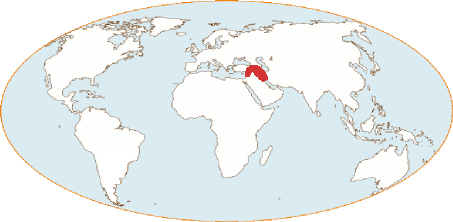Beer and wine in the palace of Qattarâ, ancient northern Syria.
Tell al Rimah, site of the ancient Qattarâ, a city incorporated for a time into the Great Assyrian Kingdom of Upper Mesopotamia, has yielded two interesting, almost contemporary palatial archives, among a few hundred tablets. One concerns beer, the second wine. Their comparison highlights some of the social characteristics of the two fermented beverages[1].
The beer is available at Qattarâ in 3 grades: good beer (kaš ỹabu), upper beer (kaš sig5) and regular beer (kaš ús), a range close to the beers known at Šubat-Enlil or Chagar Bazar. It is distributed to the staff of the palace (including a porter and a midwife), to individuals from the neighbouring villages, to messengers, to foreigners, Guti in this case. These very partial lists of beneficiaries give only a truncated picture of the importance of the brewery.
This is revealed by the large quantities of barley received by the Samkanum, brewer from the palace - sometimes more than 3,000 litres. This figure makes it possible to extrapolate the annual quantities of grain consumed and illustrates the economic weight of an activity for which the palate devotes so many grains resources. The brewer Samkanum works directly under the control of the queen Iltani who seems to have control over all the economic and domestic activities of her estate. The production of beer, proportional to the volumes of barley processed, is intended for the palatial staff.
On another side, wine is the choiced beverage for diplomatic and military manoeuvres. It is stored and transported in jars, like beer. Its distribution is calculated in number of jars. Documents record them for the use of the king, his guests or embassies, and for officers or military governors. The reign of the king Aqba-hammu knows an effervescence. Negotiations and military campaigns follow one another with the kings of Babylon, of Eluhut, of Kumme, or the Guti, herders in the mountains of Zagros. The allocations/gifts of wine vary between 2 and 18 jars per delegation. The number of jars follows the rules of protocolary precedency.
The documents from Qattarâ illustrate the highly differentiated uses of beer and wine. These two beverages never compete with each other. The palace organises the daily distribution of beer rations, thus fully playing its role as a regional economic unit responsible for managing an agricultural estate and ensuring the subsistence of its staff. On the other hand, it "offers" wine for certain occasions to its high-ranking officers. Wine has a political dimension. The daily management, of which beer is one of the material supports, gives way to the games of prestige, alliances and military power that wine symbolises.
These contrasting functions of beer and wine reflect the dual nature of the Mesopotamian palace of that time. The royal residence was both the economic centre of a more or less extensive agrarian estate and the seat of political power, with its religious dimension and its ability to forge offensive or defensive alliances with neighbouring political powers.
The use of wine has more affinities with political activities: the need for ostentation, the sharing of luxury between royal families, some "internationalised" drinking manners. Wine is traded, sold and bought through merchants or high-ranking stewards, missioned and financed by the king or his own extended family.
Mainly linked to the economic functions of the palace, beer is consumed on a daily basis by all categories of the population, far beyond the royal table and its guests. The palace brewery brings the local economic circuits into play. At the city level, it uses the grain stocks managed by the urban authorities (mayor, governor, local chief). Beer is an exchange value between the city, its inhabitants and the rural world of barley producers. When beer, or rather the brewing ingredients circulate, it is under the patronage of the palace for its agricultural operations or military campaigns.
The same uses and identical grades of beer can be found throughout northern Mesopotamia during the first half of the second millennium. An example of this situation can be found further east, with the palace of Suiliya, the first ruler of Ešnunna after the fall of the empire of Ur III in 2004. Two clay seals inscribed with names of brewers were found in the building - one of a jar, the other of a doorway to a storehouse. One of the seal legend says "Še-il-ha brewer, servant of Suiliya" [2]. At that time, the region of Ešnunna is the eastern fringe of Babylonia (Northern Mesopotamia map) and will play a major role in the political future of the region.
[1] Stephanie Dalley et al. 1976, The Old babylonians Tablets from Tell Al Rimah, 171-192. 3 kinds of beer: op. cit. tab. n° 18, 176-178, 267-271. The wine: op. cit. tab. n° 250-266.
[2] Clemens Reichel 2001, Seals and Sealings at Tell Asmar: a new look at an Ur III to Early Old Babylonian Palace, Proceedings of the 47th Rencontre Assyriologique Internationale Part II, p. 115.



